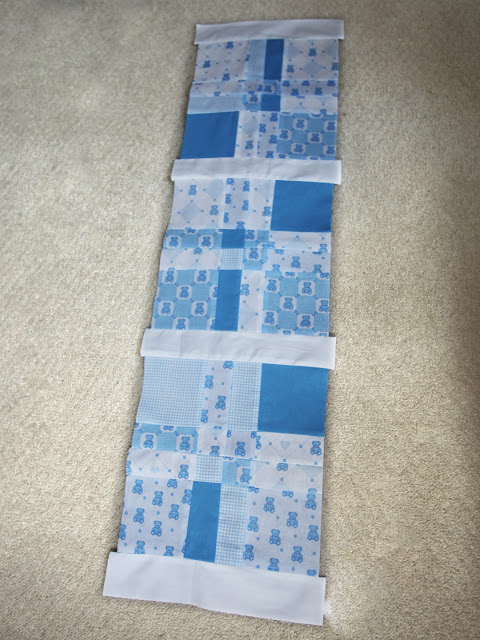 I finally finished my surprise for my cousins baby....a patchwork baby blanket. Get me.
I finally finished my surprise for my cousins baby....a patchwork baby blanket. Get me.
I've never attempted patchwork before and typical me, I pick the most complicated way to do it. Oh we'll, in at the deep end and all that.
Now it does look far more complicated than it actually is, I suppose it's more fiddly than anything, and very time consuming, but follow the below instructions if you want to try this yourself, hopefully I've explained it well enough.
There are so many ways to make a patchwork quilt, you can do plain squares, rectangles, triangles, appliqué, the list is endless. All look just as good in my opinion, you just need to settle on a style that suits you and/or the occasion.
My cousin has gone for a pretty subdued, neutral colour scheme for the baby room so I didn't want to create anything that clashed or stood out like a sore thumb. I actually found it quite hard to find the right material for this project. I tried not to go for the stereotypical 'blue' for a boy, however, that's what I ended up with, but with mixing it with white I think it came out well and looked really fresh, an almost mature baby blanket, if that makes sense? Either way, I'm pretty pleased with the end result, I'm now more confident to try a full size one now....maybe...
How to make your own binding..
....I followed a tutorial on you-tube, watch here, or follow my instructions below. It's easy to buy plain white bias binding, but if you choose to have this in a continuation of your material or a specific colour, it may well be easier to make it yourself. This process allows you to make continuous bias binding, giving you about 200inches, which was more than enough for my 46in sq blanket.
Cut out about a metre by 40in piece of material for the bias binding and fold over the edge, creating a right angle triangle and trim off. Use a rotary cutter if you have one, for a straighter edge.
Measure out 2inch lines, on the right angle. You can go thicker if you want wider binding. Go all the way to the edge of the material, until you cannot create a right angle line from top to bottom.
Trim off the remaining triangle section.
Here comes the tricky part, take the material from the bottom left and fold over, aligning the line with the second line in from the left.
Repeat this all the way along. It seems confusing but stick with it.
Once you have aligned the lines, you will have created a tube effect. Sew along the line you have pinned, trim any excess thread.
Then start to cut from the right hand side, following the lines you have drawn on the material.
As you start to cut you will see how this works, you are left with 200in of continuous bias binding - magic.
Press in half and store for later.
Voila! Bias Binding made easy.
Now, how to make the blanket....
Cut your fabric into equal size squares, if you're not using pre cut squares.

Sew together in strips of 3.
Then sew 3 strips together to make a block of 9 squares.
Don't forget to iron your seams flat!
So far so good? Now, using a rotary cutter, cut your square into 4 smaller squares.
Each new square should look like this. Realign your new squares and make new larger squares. They should have a larger square on the outsides and 4 smaller squares in the centre, sew together and iron your seams.
Lay out your squares and work out your pattern. Then calculate the size of material you want to use in between the squares, cut to length and allow for seam allowances. You can also add small patterned squares to break up the white border.
Sew the small squares onto either your side or top/bottom strips.
Sew the plain strips to the top and bottom of the squares, you will then end up with a large panel of joined up squares.
Sew on the side strips with the smaller squares, making sure all edges line up properly - this is tricky, but if your measurements are accurate you should be OK.
Continue until you have linked all squares and strips together.
Now you can do the same design for the back of the blanket. I ran out of time for this so I used a really soft, white fleece material. Which in the current climate wasn't the greatest choice, but I'm sure it will keep him warm in the winter!
Pin the front and back panels together (wrong sides together this time).
Now to add the pre-made binding.
Pin your binding in place, you need to sew one side down, all the way around first. Follow this tutorial here, which I found really useful.
Then, fold the binding over and sew around the edge of the whole blanket again.
The corners are a little tricky, so use the tutorial link above, but basically fold them down at an angle to give a neat finish.
The finished blanket - literally blood, sweat and tears to produce, but I'm incredibly happy with the result and I hope he keeps it for many years to come.
Have you made a patchwork blanket, how did it go? Any tips to share? As a novice sewer I'm always looking for and hints and tips to help the process go smoother.
Thanks for reading my blog x











































